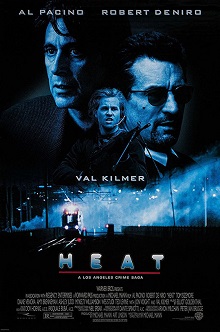Rewatching the movie 27 years later, I feel it's a real shame that Michael Mann has not been able to repeat his achievement in subsequent movies. The screenplay is extremely efficient and understated. The dialogs strive for a realistic feel on both sides of the law. None of the key information is repeated, so that the audience has to pay attention to understand the chain of events. Some plot elements are done so economically as to verge on underdevelopment --- including Natalie Portman's character and the character known as Waingro, who may or may not be a serial killer. There is a thin line between suggesting a larger world outside of the plot and tossing threads all over the place, and this movie has both.
Nearly every action set piece in the movie is well done, including a brief one involving a failed money exchange between DeNiro's Neil and a crooked financier. Mann clearly attempted to make the action as realistic as possible with minimal soundtrack and naturalistic sound design. I say "nearly" because the final showdown between Neil and Pacino's Vincent is a disappointment, which did not improve on second viewing. After all the impeccable scenes previously, the chase and the conclusion seem too long and somewhat confusing. Can a person get from the hotel to the runways of LAX on foot? (Why is the hotel next door to LAX in the first place?) Where was the plane that was going to be Neil's escape? Where is the money? Without the money, does Neil really have a reason to get to the airport anyway? How far behind him was Vincent? (The scene has him either very far behind or very close.) If Mann intended the final chase to be anticlimactic and somewhat pathetic, I would be OK with that, but the intention is not clearly conveyed on screen.
On second viewing, Pacino's performance is particularly jarring when he is surrounded by the understated and matter-of-fact approach from just about everyone. He really stood out like a sore thumb. According to reviews, it was apparently Mann's decision to make the character so ... flamboyant? aggressive? loud? unstable? I guess he wanted a stark contrast between DeNiro's internalized Neil and the half-crazed policeman for unexpected effects. However, everything about Vincent rings false. First and foremost, Pacino reeks of New York and does not fit into the Los Angeles surrounding at all. I know because I spent my formative years there. From his costume to his accent to the manners, Pacino seems to be in a totally different movie. In one scene, Vincent is standing in front of a kitchen sink full of dirty dishes, contemplating washing them, in his suit. Does he ever wash dishes? Does Mann? It looks so fake as to be almost laughable. It is baffling.
Talk about baffling, it is both interesting and a little hilarious that Mann decided to give every male character a woman, except the financial guy and Waingro, who are apparently considered the lowest of the low. Every single one of the career criminals has a woman in his life. Neil falls hopelessly in love with Judging Amy (oops, that's what I remember Amy Brenneman from). At some point I was thinking that only the Hispanic guy played by Danny Trejo didn't have a woman to warm his bed, and then the movie immediately proved me wrong. So this must mean something. Mann did not stuff his movie with so many side characters for nothing. Heck, the camera even lingered on a woman in the arm of a policeman in one scene.
Obviously Mann had something to say about the relationship of violent men (on both sides of the law) and the women in their lives. Throughout most of the movie, I thought the point was how delusional they are and how they are incapable of constructing a normal and sane life, as represented by women. But Amy Brenneman's character proves me wrong: Look, here is a woman living a normal life as a graphic designer, who is willing to give up everything to run off with this master criminal! I guess his message is, maybe, that no woman can resist the romanticism represented by violent men? I am not against this theme at all, but it contradicts 80% of the movie that comes before it ...


No comments:
Post a Comment